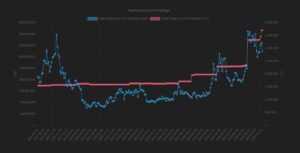As the doom-mongers gather together in dark rooms to conspire against your reason and rob you of your common sense, I’d like to turn your attention to the silver lining that openly presents itself during this crucial moment in world history.
To delve into this unprecedented time in history and in the macro-global economy, I’ll look solely at developments in the United States. As the world leader, the United States is the canary in the coal-mine and the harbinger of things to come in Europe and elsewhere, at least from a money point of view.
Central banks and inflation fears
The US Federal Reserve has cut down interest rates to zero and the plan is to keep these rates at zero for the foreseeable future. Multiple stimulus packages in 2020 now total over $3 trillion in quantitative easing and another $2 trillion are on the way. The US Federal Reserve’s balance sheet has exploded by 75% since the beginning of the year and the same can be said for the European Central Bank (ECB) and all other central banks to varying degrees.
While there is a good argument that this round of QE won’t lead to higher inflation due to the current corona-induced deflationary environment, the Fed has publicly committed to sustaining a 2%+ inflation level. Additionally, various emergent data sets from the CDC and other national health services continue to show that the underlying causes for current deflationary conditions are on the verge of getting debunked; and I expect more discussions on this, not less.
Today, the average investors fears inflation, regardless of whether we actually see that inflation or not. This fear has driven significant capital into inflationary hedges such as gold, bitcoin, real estate and other assets deemed to retain value against such a backdrop. Put together, the Fed’s asset price manipulation and prevalent market inflation fears have driven both bitcoin and gold into another another boom cycle, and possibly into another paradigm wherein bitcoin will head between ten to twenty times higher by the end of 2021.
Institutions waking up to the bitcoin trade
To buttress this argument, let’s first take a closer look at the demand side of the equation. Indeed, as the macro environment serves as a constant fuel, bitcoin is up more than 50% year-to-date and continues to outpace most assets on the market. This persistent zero rate environment and quantitative easing will continue to push demand towards higher and higher levels.
Meanwhile, we’re seeing traditional asset management firms beginning to take the leap to own bitcoin. Such stories often come and go quickly as new information enters our collective consciousness; but they are still no less important. Fidelity investments recently published a paper revealing clear alpha-generating impact bitcoin is having on client portfolios – to the tune of 1%-5%. Stone Ridge, an asset management firm now owns $115 million in bitcoin. Paul Tudor Jones publicly announced that he put 2% of his assets into bitcoin. Public pensions funds in the US have also gained exposure to bitcoin via fund managers. Grayscale, which is the largest digital assets investment firm saw record inflows this year and holds over $6 billion in total assets under management.
This list does not end there. I could go on at length.
Clearly, the Wall Street sleeping giant has discovered the bitcoin trade. However, this surge in demand is not only happening within the traditional financial environment. There is now another trend emerging whereby publicly traded corporations are acquiring bitcoin as part of company treasury reserves. The trend started with companies like Galaxy Digital and others. Shortly after, MicroStrategy ($1.2 billion + market cap on the NASDAQ) put down 85% of their $500 million balance sheet into bitcoin. More recently, fintech firm Square announced a purchase of $50 million worth of bitcoin on their balance sheet (1% of their assets).
This uptick in demand is just the beginning in my opinion.
All these forward-looking firms have started something and their peers will join them. As such, the demand outlook is not only strong, but shows clear signs of acceleration into 2021.
The bitcoin life-line is getting shorter
Now that we’ve more or less covered the demand side of the equation, let’s look at the supply-side.
There are only 21 million bitcoin that will ever exist. Today, there are approximately 18.4 million of them in circulation. Bitcoin enters the market every day at a pre-determined time that is hard-coded into software that cannot be altered without the agreement of 51% or more of users – i.e. it won’t change. That monetary supply started in 2009 with 7,200 bitcoin being circulated each day, which continued for four years before the 7,200 daily supply was cut to 3,600, and then to 1,800 four years later. Every four years, this process continued and in May 2020, we experienced the latest “bitcoin halving” which now has 900 bitcoin per day entering the circulating supply.
These supply shocks have historically led to price increases of twenty times plus in the 18 months following the event.
To briefly summarize this: we have significant increases in demand and an unalterable supply shock that has historically led to big price increases. These two factors alone should be compelling enough to ensure that you have some exposure to bitcoin, perhaps not more than 1%-10% of your portfolio. The asymmetric risk-reward situation does not exist in any other asset your are currently invested in, especially if all your assets are held in dollars or euros.
That’s not all, however. There is a third factor that you should consider.
In the last 12 months, more than 60% of the total bitcoin in circulation has not exchanged or traded hands. This means that a landslide majority of bitcoin investors have been through hell and back, stomaching multiple double-digit price movements both up and down, and still continue to hold the asset. These people have even been through a 50% price drop without selling, which happened in a single day in March 2020.
Why would anyone do such a thing? Because bitcoin is the greatest monetary invention of all time and nothing has shaken this unanimous conviction. As such, the likelihood for the 11 million plus bitcoin currently held by strong hands will trade in the short term is extremely low.
A bitcoin crescendo moment in 2021
The situation could also be evaluated in a numeric way, such that (1) demand is increasing significantly, (2) the supply shock has made bitcoin scarcer, and (3) the life line is much shorter than people realise. This leads me to conclude that bitcoin is about to see an explosive move upwards by the end of next year. I expect bitcoin to hit at least $20,000 early next year and $100,000 by the end of 2021. The more bullish scenario would see bitcoin priced at $250,000 in 2022 if bitcoin trends towards a multi-year bull cycle.
Of course, bitcoin is a volatile asset and will not go in a straight line up. Historically, bitcoin has seen anything between 15%-30% pullbacks along the way, but I believe these price-levels are achievable within the next 15 months. On a longer time horizon, things become even more interesting.
In a world of unlimited cash, both gold and bitcoin are contenders of sound money principles. Gold is old school and bitcoin is the digital native solution. Gold’s market capitalisation is at $8 trillion and bitcoin’s is a little over $200 billion. It’s likely that in time, bitcoin will not only eclipse gold’s market cap, but dwarf it. If the historical cycles continue to play out, then there will be another bear market before bitcoin surpasses gold’s market cap.
However, this write-up is not meant to convince you of bitcoin’s 10-year potential, but rather to explain the current situation at hand and how bitcoin fits into it.
I trust you will listen to your faculties of reason and make the right choice.
This is not financial advice.
Join the telegram channel for updates, charts, ideas and deals.


